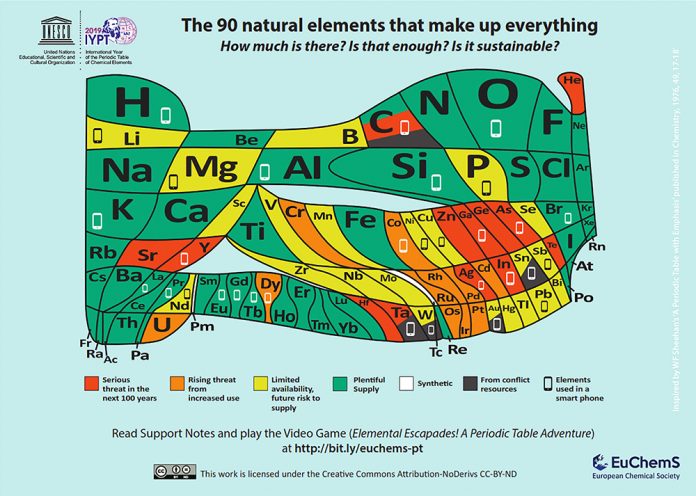The European Chemistry Society’s Element Scarcity Periodic Table has been updated to reflect the significance of carbon in the wake of COP26.
The table organises all discovered chemical elements to allow scientists to quickly refer to an element’s properties such as its atomic mass and chemical symbol.
The European Chemical Society (EuChemS) has released an updated version of its Periodic Table, first produced for the International Year of the Periodic Table in 2019.
That version highlighted element availability and vulnerability and was created by a task group chaired by former President of the Society, University of St Andrews Professor of Chemistry, Professor David Cole-Hamilton.
The new updated version highlights the problems of carbon today. Usually green, carbon features in the new table as a tricolour of green, red and grey which each represent a separate attribute of carbon.
The green represents the plentifulness of carbon in the form of carbon dioxide, carbonate rocks and vegetation; red represents that this plentifulness will cause serious problems if nothing is done to restrict its use; and grey reflects the fact that carbon resources, especially oil, can emanate from conflict resources such as from countries at war over oilfields or where oil revenues are used to fight wars.
Professor David Cole-Hamilton said: “This updated version of the Periodic Table graphically highlights the problems of carbon in our world now.
“If we behave responsibly by cutting our dependence on fossil fuels and never using them from conflict resources, we can save our beautiful and diverse planet and restore carbon to its rightful green colour.”
The carbon cycle balances photosynthesis, by which plants grow taking up carbon dioxide (CO2), with respiration (breathing) by which humans and all flora and fauna live and give out CO2.
For millennia these two processes, compounded by CO2 absorption and release by the oceans, have been in balance justifying the benign green colour given to carbon in the 2019 Periodic Table.
Burning carbon-based fuels (coal, oil, gas) pumps so much extra CO2 into the air that photosynthesis and the oceans can’t keep up, causing CO2 levels to rise leading to global warming and climate change that will cause severe disruption to all forms of life on the planet in very much fewer than 100 years if humanity does nothing, hence the red colour.
The grey colour arises because, although most coal, oil and gas extraction is untainted by conflict, the proceeds of some oil sales are used to fund wars.
The updated version of the EuChemS Periodic Table can be downloaded from bit.ly/euchems-pt









